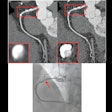Dear AuntMinnie Member,
Do you know anyone who deserves a Minnie?
We're talking, of course, about the Minnies awards, AuntMinnie.com's annual event recognizing excellence in radiology. We've just opened the nominations phase of the 16th annual edition of the Minnies, giving you the chance to let us know who you believe should be in the running for radiology's most prestigious award.
There are 15 Minnies categories, ranging from Most Influential Radiology Researcher to Best Radiology Mobile App. The categories run the gamut from products and educators to scientific papers and training programs.
The Minnies give you the opportunity to tell us what's right with radiology. We'll take your suggestions and create a list of candidates that will be voted on by our expert panel, with winners announced before the RSNA 2015 meeting later this year.
To nominate someone you think is deserving, click here or head over to minnies.auntminnie.com. It takes just a few minutes, and someone you know may thank you!
CT linked to DNA damage
A new study published this week in JACC: Cardiovascular Imaging is linking radiation from cardiac CT angiography (CCTA) exams to DNA damage sustained by patients in the weeks after the scans took place. The research highlights the disturbing relationship between medical radiation and cell mutations that could later lead to cancer.
But the news isn't all bad for medical imaging. While the researchers found signs of DNA damage and programmed cell death from some CCTA exams, they found no evidence of damage at radiation dose levels below 7.5 mSv. And they found no evidence of DNA damage in a subgroup of patients who were scanned with newer low-dose imaging technologies.
The research could indicate that there's a threshold of radiation dose below which DNA damage is at least minimized, and with a little effort many types of CT scans can be performed below that threshold. The trick is how to get high-dose studies such as CCTA and interventional exams down to that level. Read more by clicking here.
More AHRA news
In a related vein, our coverage of this week's AHRA meeting in Las Vegas continues with an article on how to reduce radiation dose at your imaging facility.
Robert Pizzutiello of Landauer Medical Physics reviewed the landscape of radiation dose, including requirements for dose monitoring and reporting by both the states and the Joint Commission. While reducing radiation dose across an enterprise is a relatively simple concept to understand, it isn't necessarily easy, he believes. Get some tips by clicking here.
Finally, learn how to avoid having your submissions for Medicare CT reimbursement denied in this article by Jeff Majchrzak of Panacea Healthcare Solutions.
Get these stories and more by visiting our CT Community at ct.auntminnie.com.



















